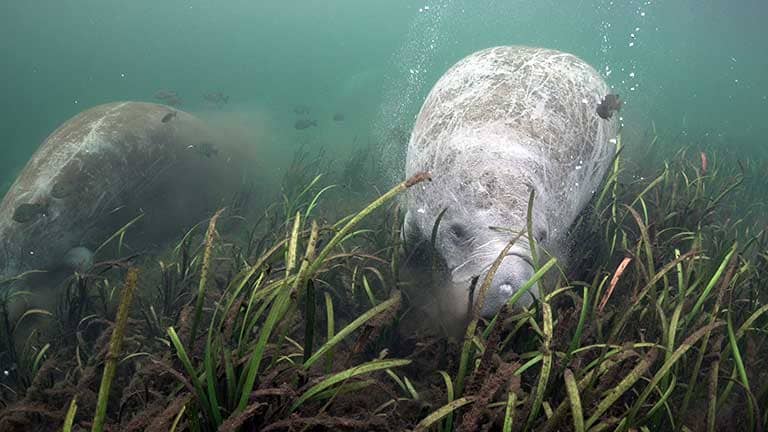THE LIFELINE OF COASTAL WATERS
Seagrasses hold significant importance for many reasons. Seagrasses serve as a primary food supply for various marine life forms, encompassing fish, shrimp, crabs, and other invertebrates. These underwater meadows offer nourishment and refuge to a diverse range of marine creatures, creating a sheltered haven from both predators and environmental elements.
- Fish: sea bass, flounder, mullet, sea trout, snapper
- Shrimp: pink shrimp, white shrimp
- Crabs: blue crab, stone crab
- Invertebrates: sea urchins, sea stars, snails, worms
Seagrasses play a pivotal role in enhancing water quality. By absorbing nutrients in the water, they actively lessen the propagation of algae blooms and improve water clarity. In addition, they fulfill a crucial filtration function, extracting pollutants from the surrounding water. Seagrasses can remove up to 90% of the nitrogen and phosphorus from the water column.
In terms of ecological stability, seagrasses function as natural shoreline protectors. The intertwining roots of these plants bind sediments together, thus thwarting erosion by up to 90%, particularly during severe weather conditions like storms and hurricanes.
Seagrasses also contribute to carbon storage. By storing carbon within their leaves, stems, and roots, they help to counteract climate change. They can store up to 10x more carbon than a rainforest of the same size.
Economically, seagrasses wield substantial influence. They bolster various commercial and recreational fisheries, fostering thriving industries. Furthermore, they cultivate opportunities for tourism and recreation, further increasing their value.

THE GROWTH AND FLOURISHING OF SEAGRASS ECOSYSTEMS
Seagrasses thrive in shallow waters, relying on clear, nutrient-rich waters with plenty of sunlight for photosynthesis. Their preferred depth is typically within 60 feet of the surface due to their sunlight requirement. While adaptable to diverse water temperatures, seagrasses favor a range between 68 and 86 degrees Fahrenheit for optimal growth.
Seagrasses exhibit growth both vertically and horizontally. Their leaves extend upwards, adeptly harnessing sunlight, while their roots extend downward into the sediment to extract essential nutrients. Remarkably, seagrasses can achieve a growth rate of up to 12 inches daily and have the potential to endure for as long as 20 years.
Seagrasses can reproduce both sexually and asexually. Sexual reproduction transpires through pollination — one plant’s pollen is captured by another plant’s eggs. Conversely, asexual reproduction happens when a new plant emerges from a fragment of an established one.
Seagrasses need several things to grow and thrive, including:
- Sunlight: Seagrasses are photosynthetic, which means they use sunlight to create food. They need at least six hours of sunlight daily to grow and survive.
- Water: Seagrasses need clean, clear water to grow. They are sensitive to pollution and can be damaged by excess nutrients, sediment, and toxins.
- Nutrients: Seagrasses need nutrients to grow. They get their nutrients from the water column and the sediment.
- Sediment: Seagrasses need a soft, sandy substrate to grow. They can’t grow on hard surfaces like rocks or concrete.
- Temperature: Seagrasses can grow in various water temperatures, but prefer water between 68 and 86 degrees Fahrenheit.
- Salinity: Seagrasses can grow in various salinities, but prefer water that is between 25 and 35 parts per thousand.
When seagrasses have all these things, they can grow and thrive. They provide food and shelter for numerous forms of marine life, and they help improve water quality. Seagrasses are an essential part of the aquatic ecosystem, and it is vital to protect them.

